Strategic Recommendations for David Jones Pty Limited
VerifiedAdded on 2023/06/03
|11
|3257
|202
AI Summary
This report provides strategic recommendations for David Jones Pty Limited, an upmarket departmental store in Australia and New Zealand. The report includes market size and trends, financial and corporate performance, strategic options, recommended strategy, implementation of strategy, and monitoring and control of future performance.
Contribute Materials
Your contribution can guide someone’s learning journey. Share your
documents today.
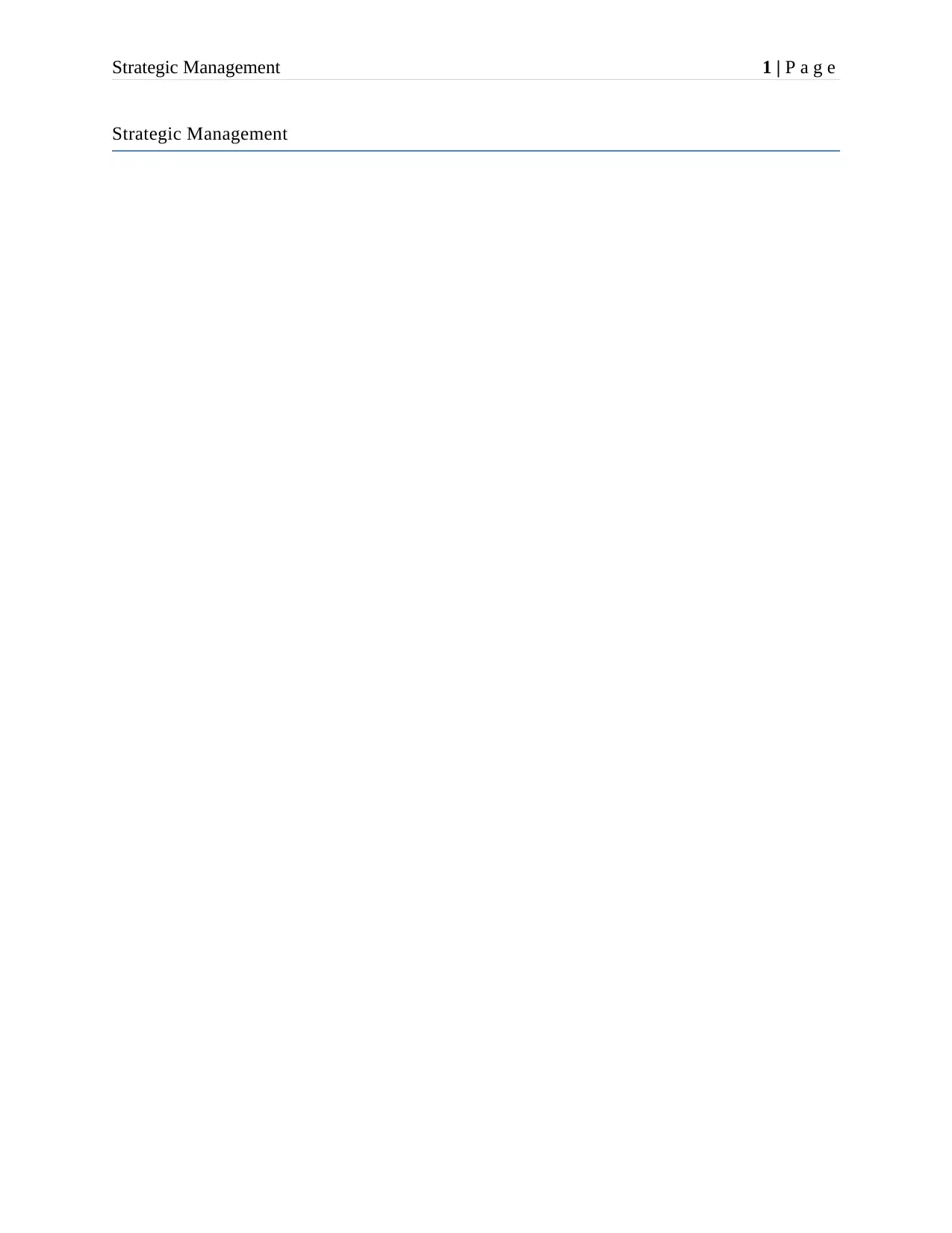
Strategic Management 1 | P a g e
Strategic Management
Strategic Management
Secure Best Marks with AI Grader
Need help grading? Try our AI Grader for instant feedback on your assignments.
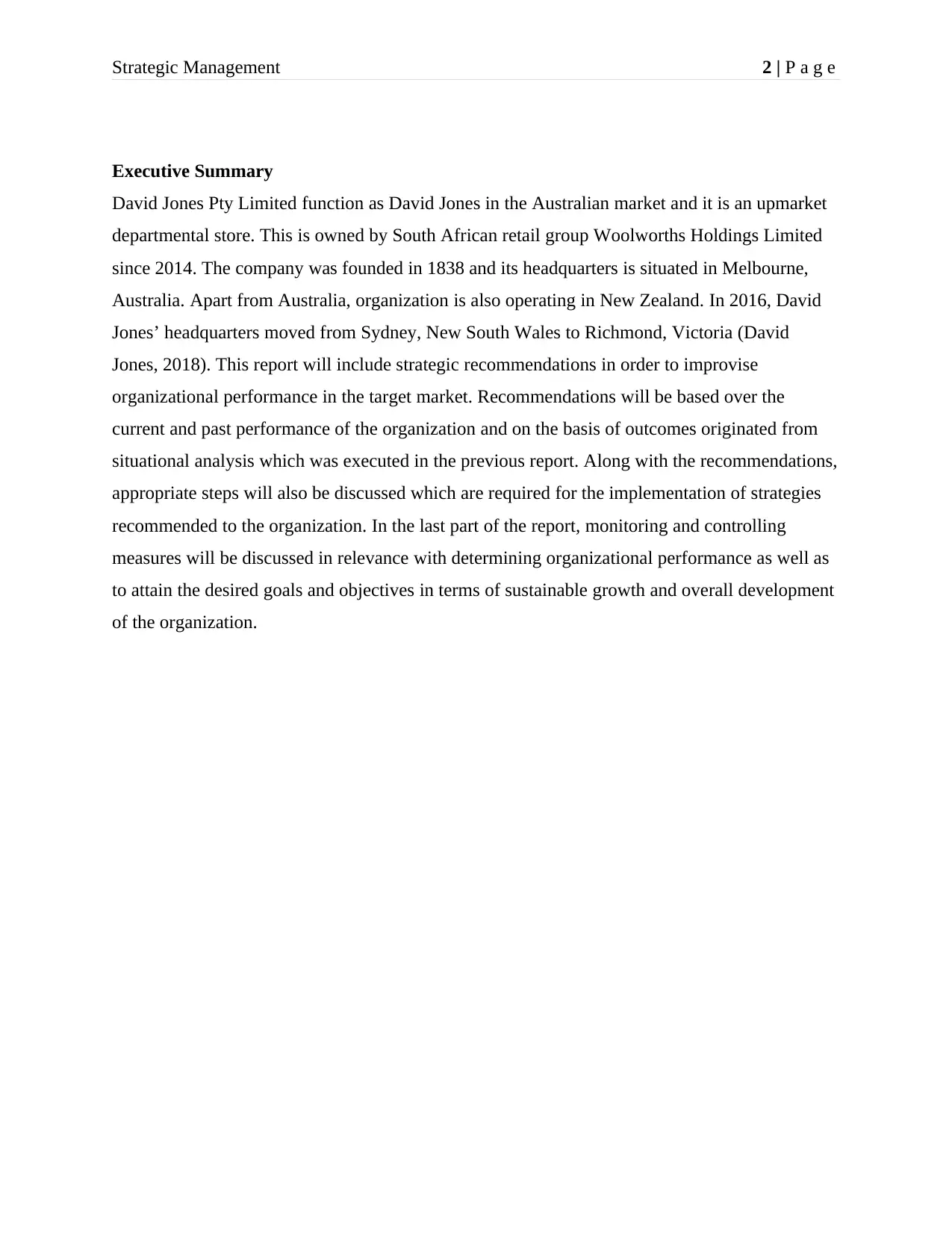
Strategic Management 2 | P a g e
Executive Summary
David Jones Pty Limited function as David Jones in the Australian market and it is an upmarket
departmental store. This is owned by South African retail group Woolworths Holdings Limited
since 2014. The company was founded in 1838 and its headquarters is situated in Melbourne,
Australia. Apart from Australia, organization is also operating in New Zealand. In 2016, David
Jones’ headquarters moved from Sydney, New South Wales to Richmond, Victoria (David
Jones, 2018). This report will include strategic recommendations in order to improvise
organizational performance in the target market. Recommendations will be based over the
current and past performance of the organization and on the basis of outcomes originated from
situational analysis which was executed in the previous report. Along with the recommendations,
appropriate steps will also be discussed which are required for the implementation of strategies
recommended to the organization. In the last part of the report, monitoring and controlling
measures will be discussed in relevance with determining organizational performance as well as
to attain the desired goals and objectives in terms of sustainable growth and overall development
of the organization.
Executive Summary
David Jones Pty Limited function as David Jones in the Australian market and it is an upmarket
departmental store. This is owned by South African retail group Woolworths Holdings Limited
since 2014. The company was founded in 1838 and its headquarters is situated in Melbourne,
Australia. Apart from Australia, organization is also operating in New Zealand. In 2016, David
Jones’ headquarters moved from Sydney, New South Wales to Richmond, Victoria (David
Jones, 2018). This report will include strategic recommendations in order to improvise
organizational performance in the target market. Recommendations will be based over the
current and past performance of the organization and on the basis of outcomes originated from
situational analysis which was executed in the previous report. Along with the recommendations,
appropriate steps will also be discussed which are required for the implementation of strategies
recommended to the organization. In the last part of the report, monitoring and controlling
measures will be discussed in relevance with determining organizational performance as well as
to attain the desired goals and objectives in terms of sustainable growth and overall development
of the organization.
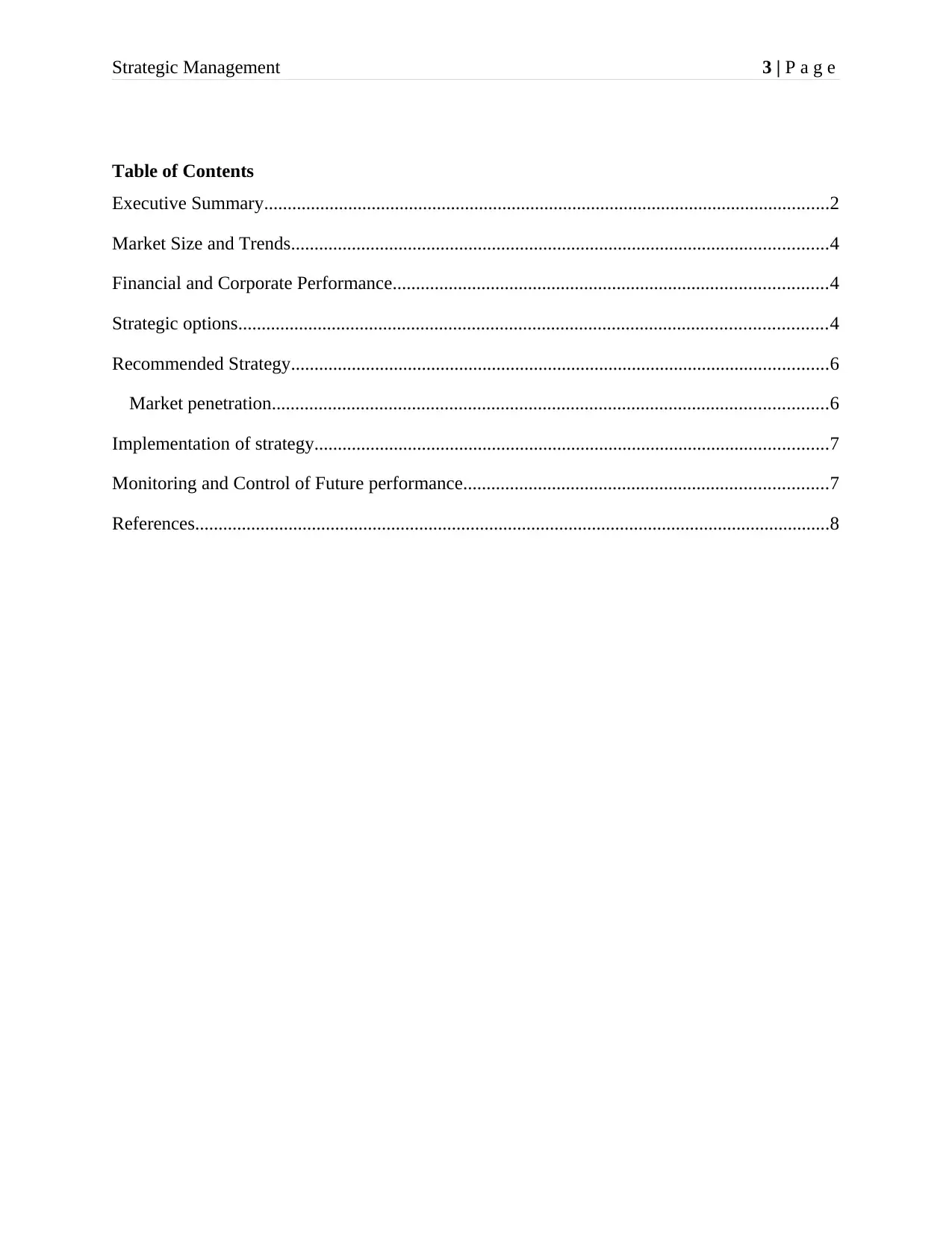
Strategic Management 3 | P a g e
Table of Contents
Executive Summary.........................................................................................................................2
Market Size and Trends...................................................................................................................4
Financial and Corporate Performance.............................................................................................4
Strategic options..............................................................................................................................4
Recommended Strategy...................................................................................................................6
Market penetration.......................................................................................................................6
Implementation of strategy..............................................................................................................7
Monitoring and Control of Future performance..............................................................................7
References........................................................................................................................................8
Table of Contents
Executive Summary.........................................................................................................................2
Market Size and Trends...................................................................................................................4
Financial and Corporate Performance.............................................................................................4
Strategic options..............................................................................................................................4
Recommended Strategy...................................................................................................................6
Market penetration.......................................................................................................................6
Implementation of strategy..............................................................................................................7
Monitoring and Control of Future performance..............................................................................7
References........................................................................................................................................8
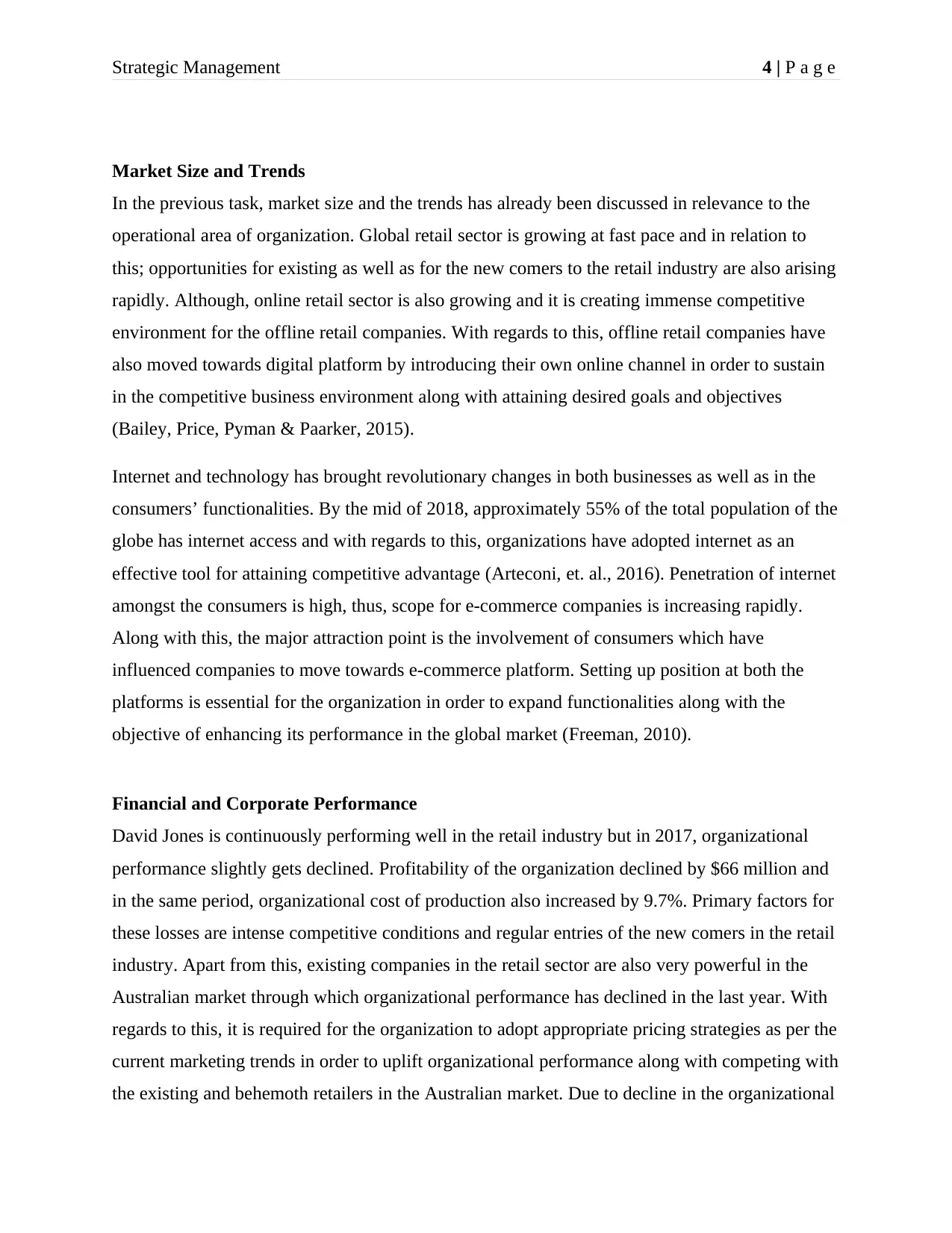
Strategic Management 4 | P a g e
Market Size and Trends
In the previous task, market size and the trends has already been discussed in relevance to the
operational area of organization. Global retail sector is growing at fast pace and in relation to
this; opportunities for existing as well as for the new comers to the retail industry are also arising
rapidly. Although, online retail sector is also growing and it is creating immense competitive
environment for the offline retail companies. With regards to this, offline retail companies have
also moved towards digital platform by introducing their own online channel in order to sustain
in the competitive business environment along with attaining desired goals and objectives
(Bailey, Price, Pyman & Paarker, 2015).
Internet and technology has brought revolutionary changes in both businesses as well as in the
consumers’ functionalities. By the mid of 2018, approximately 55% of the total population of the
globe has internet access and with regards to this, organizations have adopted internet as an
effective tool for attaining competitive advantage (Arteconi, et. al., 2016). Penetration of internet
amongst the consumers is high, thus, scope for e-commerce companies is increasing rapidly.
Along with this, the major attraction point is the involvement of consumers which have
influenced companies to move towards e-commerce platform. Setting up position at both the
platforms is essential for the organization in order to expand functionalities along with the
objective of enhancing its performance in the global market (Freeman, 2010).
Financial and Corporate Performance
David Jones is continuously performing well in the retail industry but in 2017, organizational
performance slightly gets declined. Profitability of the organization declined by $66 million and
in the same period, organizational cost of production also increased by 9.7%. Primary factors for
these losses are intense competitive conditions and regular entries of the new comers in the retail
industry. Apart from this, existing companies in the retail sector are also very powerful in the
Australian market through which organizational performance has declined in the last year. With
regards to this, it is required for the organization to adopt appropriate pricing strategies as per the
current marketing trends in order to uplift organizational performance along with competing with
the existing and behemoth retailers in the Australian market. Due to decline in the organizational
Market Size and Trends
In the previous task, market size and the trends has already been discussed in relevance to the
operational area of organization. Global retail sector is growing at fast pace and in relation to
this; opportunities for existing as well as for the new comers to the retail industry are also arising
rapidly. Although, online retail sector is also growing and it is creating immense competitive
environment for the offline retail companies. With regards to this, offline retail companies have
also moved towards digital platform by introducing their own online channel in order to sustain
in the competitive business environment along with attaining desired goals and objectives
(Bailey, Price, Pyman & Paarker, 2015).
Internet and technology has brought revolutionary changes in both businesses as well as in the
consumers’ functionalities. By the mid of 2018, approximately 55% of the total population of the
globe has internet access and with regards to this, organizations have adopted internet as an
effective tool for attaining competitive advantage (Arteconi, et. al., 2016). Penetration of internet
amongst the consumers is high, thus, scope for e-commerce companies is increasing rapidly.
Along with this, the major attraction point is the involvement of consumers which have
influenced companies to move towards e-commerce platform. Setting up position at both the
platforms is essential for the organization in order to expand functionalities along with the
objective of enhancing its performance in the global market (Freeman, 2010).
Financial and Corporate Performance
David Jones is continuously performing well in the retail industry but in 2017, organizational
performance slightly gets declined. Profitability of the organization declined by $66 million and
in the same period, organizational cost of production also increased by 9.7%. Primary factors for
these losses are intense competitive conditions and regular entries of the new comers in the retail
industry. Apart from this, existing companies in the retail sector are also very powerful in the
Australian market through which organizational performance has declined in the last year. With
regards to this, it is required for the organization to adopt appropriate pricing strategies as per the
current marketing trends in order to uplift organizational performance along with competing with
the existing and behemoth retailers in the Australian market. Due to decline in the organizational
Secure Best Marks with AI Grader
Need help grading? Try our AI Grader for instant feedback on your assignments.
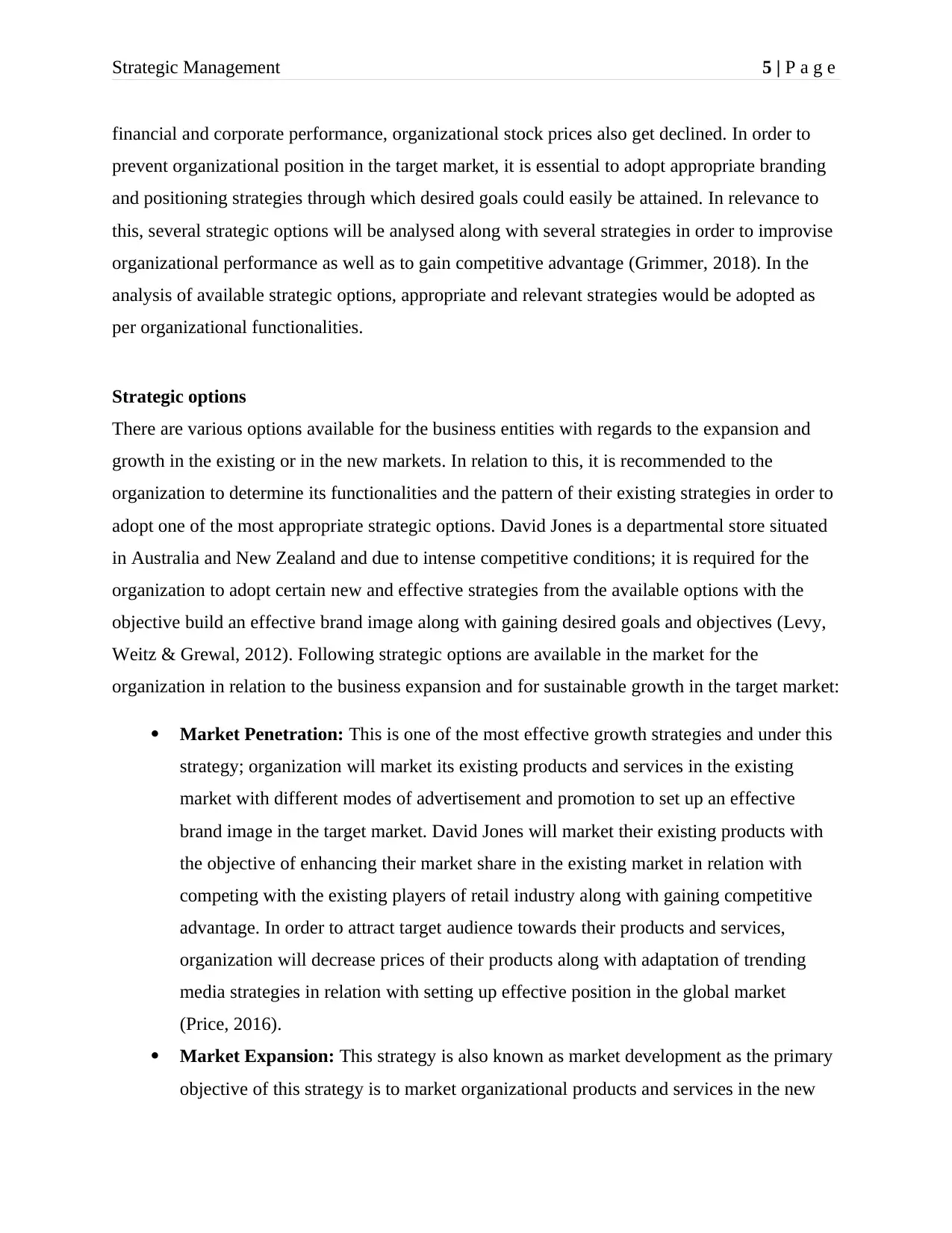
Strategic Management 5 | P a g e
financial and corporate performance, organizational stock prices also get declined. In order to
prevent organizational position in the target market, it is essential to adopt appropriate branding
and positioning strategies through which desired goals could easily be attained. In relevance to
this, several strategic options will be analysed along with several strategies in order to improvise
organizational performance as well as to gain competitive advantage (Grimmer, 2018). In the
analysis of available strategic options, appropriate and relevant strategies would be adopted as
per organizational functionalities.
Strategic options
There are various options available for the business entities with regards to the expansion and
growth in the existing or in the new markets. In relation to this, it is recommended to the
organization to determine its functionalities and the pattern of their existing strategies in order to
adopt one of the most appropriate strategic options. David Jones is a departmental store situated
in Australia and New Zealand and due to intense competitive conditions; it is required for the
organization to adopt certain new and effective strategies from the available options with the
objective build an effective brand image along with gaining desired goals and objectives (Levy,
Weitz & Grewal, 2012). Following strategic options are available in the market for the
organization in relation to the business expansion and for sustainable growth in the target market:
Market Penetration: This is one of the most effective growth strategies and under this
strategy; organization will market its existing products and services in the existing
market with different modes of advertisement and promotion to set up an effective
brand image in the target market. David Jones will market their existing products with
the objective of enhancing their market share in the existing market in relation with
competing with the existing players of retail industry along with gaining competitive
advantage. In order to attract target audience towards their products and services,
organization will decrease prices of their products along with adaptation of trending
media strategies in relation with setting up effective position in the global market
(Price, 2016).
Market Expansion: This strategy is also known as market development as the primary
objective of this strategy is to market organizational products and services in the new
financial and corporate performance, organizational stock prices also get declined. In order to
prevent organizational position in the target market, it is essential to adopt appropriate branding
and positioning strategies through which desired goals could easily be attained. In relevance to
this, several strategic options will be analysed along with several strategies in order to improvise
organizational performance as well as to gain competitive advantage (Grimmer, 2018). In the
analysis of available strategic options, appropriate and relevant strategies would be adopted as
per organizational functionalities.
Strategic options
There are various options available for the business entities with regards to the expansion and
growth in the existing or in the new markets. In relation to this, it is recommended to the
organization to determine its functionalities and the pattern of their existing strategies in order to
adopt one of the most appropriate strategic options. David Jones is a departmental store situated
in Australia and New Zealand and due to intense competitive conditions; it is required for the
organization to adopt certain new and effective strategies from the available options with the
objective build an effective brand image along with gaining desired goals and objectives (Levy,
Weitz & Grewal, 2012). Following strategic options are available in the market for the
organization in relation to the business expansion and for sustainable growth in the target market:
Market Penetration: This is one of the most effective growth strategies and under this
strategy; organization will market its existing products and services in the existing
market with different modes of advertisement and promotion to set up an effective
brand image in the target market. David Jones will market their existing products with
the objective of enhancing their market share in the existing market in relation with
competing with the existing players of retail industry along with gaining competitive
advantage. In order to attract target audience towards their products and services,
organization will decrease prices of their products along with adaptation of trending
media strategies in relation with setting up effective position in the global market
(Price, 2016).
Market Expansion: This strategy is also known as market development as the primary
objective of this strategy is to market organizational products and services in the new
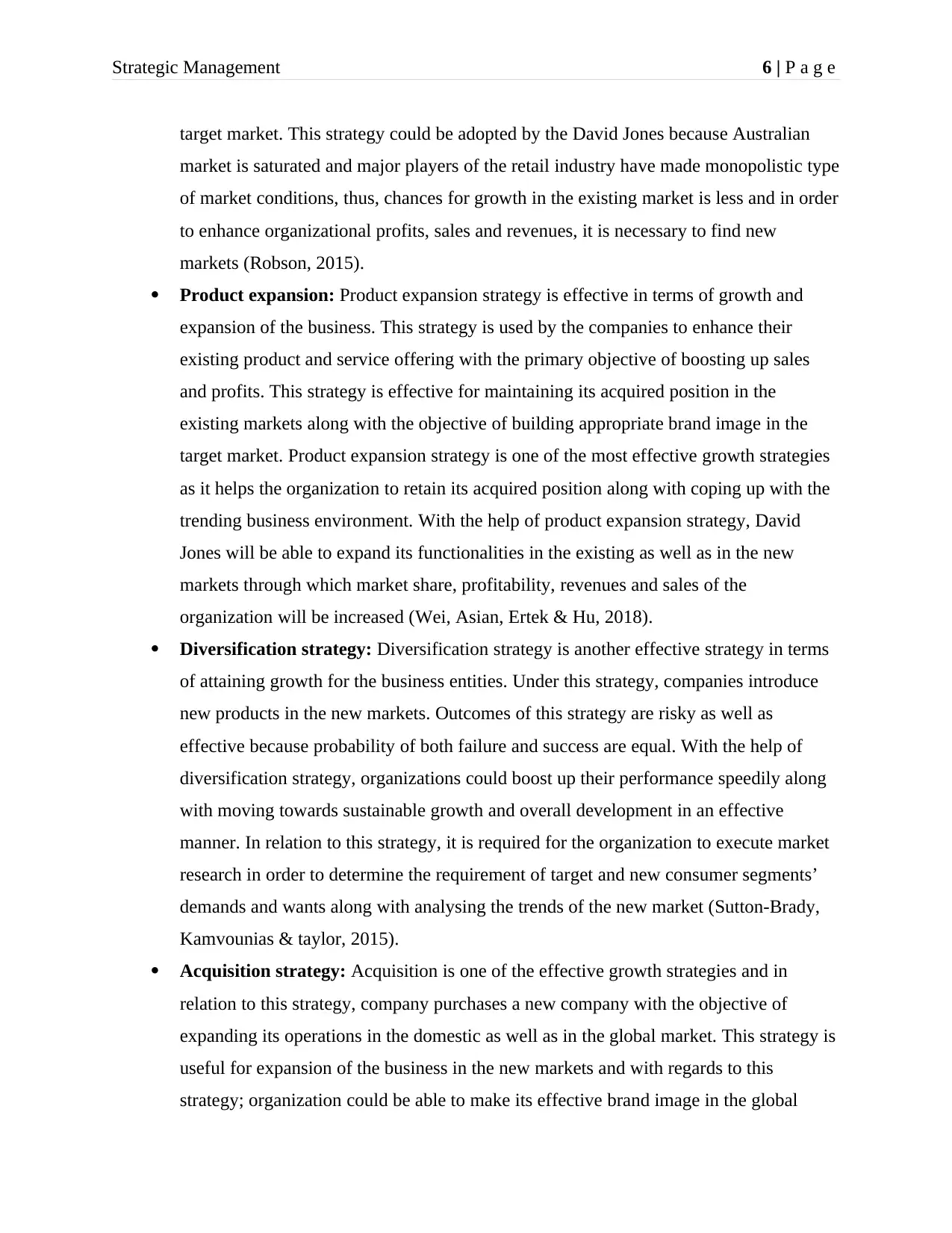
Strategic Management 6 | P a g e
target market. This strategy could be adopted by the David Jones because Australian
market is saturated and major players of the retail industry have made monopolistic type
of market conditions, thus, chances for growth in the existing market is less and in order
to enhance organizational profits, sales and revenues, it is necessary to find new
markets (Robson, 2015).
Product expansion: Product expansion strategy is effective in terms of growth and
expansion of the business. This strategy is used by the companies to enhance their
existing product and service offering with the primary objective of boosting up sales
and profits. This strategy is effective for maintaining its acquired position in the
existing markets along with the objective of building appropriate brand image in the
target market. Product expansion strategy is one of the most effective growth strategies
as it helps the organization to retain its acquired position along with coping up with the
trending business environment. With the help of product expansion strategy, David
Jones will be able to expand its functionalities in the existing as well as in the new
markets through which market share, profitability, revenues and sales of the
organization will be increased (Wei, Asian, Ertek & Hu, 2018).
Diversification strategy: Diversification strategy is another effective strategy in terms
of attaining growth for the business entities. Under this strategy, companies introduce
new products in the new markets. Outcomes of this strategy are risky as well as
effective because probability of both failure and success are equal. With the help of
diversification strategy, organizations could boost up their performance speedily along
with moving towards sustainable growth and overall development in an effective
manner. In relation to this strategy, it is required for the organization to execute market
research in order to determine the requirement of target and new consumer segments’
demands and wants along with analysing the trends of the new market (Sutton-Brady,
Kamvounias & taylor, 2015).
Acquisition strategy: Acquisition is one of the effective growth strategies and in
relation to this strategy, company purchases a new company with the objective of
expanding its operations in the domestic as well as in the global market. This strategy is
useful for expansion of the business in the new markets and with regards to this
strategy; organization could be able to make its effective brand image in the global
target market. This strategy could be adopted by the David Jones because Australian
market is saturated and major players of the retail industry have made monopolistic type
of market conditions, thus, chances for growth in the existing market is less and in order
to enhance organizational profits, sales and revenues, it is necessary to find new
markets (Robson, 2015).
Product expansion: Product expansion strategy is effective in terms of growth and
expansion of the business. This strategy is used by the companies to enhance their
existing product and service offering with the primary objective of boosting up sales
and profits. This strategy is effective for maintaining its acquired position in the
existing markets along with the objective of building appropriate brand image in the
target market. Product expansion strategy is one of the most effective growth strategies
as it helps the organization to retain its acquired position along with coping up with the
trending business environment. With the help of product expansion strategy, David
Jones will be able to expand its functionalities in the existing as well as in the new
markets through which market share, profitability, revenues and sales of the
organization will be increased (Wei, Asian, Ertek & Hu, 2018).
Diversification strategy: Diversification strategy is another effective strategy in terms
of attaining growth for the business entities. Under this strategy, companies introduce
new products in the new markets. Outcomes of this strategy are risky as well as
effective because probability of both failure and success are equal. With the help of
diversification strategy, organizations could boost up their performance speedily along
with moving towards sustainable growth and overall development in an effective
manner. In relation to this strategy, it is required for the organization to execute market
research in order to determine the requirement of target and new consumer segments’
demands and wants along with analysing the trends of the new market (Sutton-Brady,
Kamvounias & taylor, 2015).
Acquisition strategy: Acquisition is one of the effective growth strategies and in
relation to this strategy, company purchases a new company with the objective of
expanding its operations in the domestic as well as in the global market. This strategy is
useful for expansion of the business in the new markets and with regards to this
strategy; organization could be able to make its effective brand image in the global
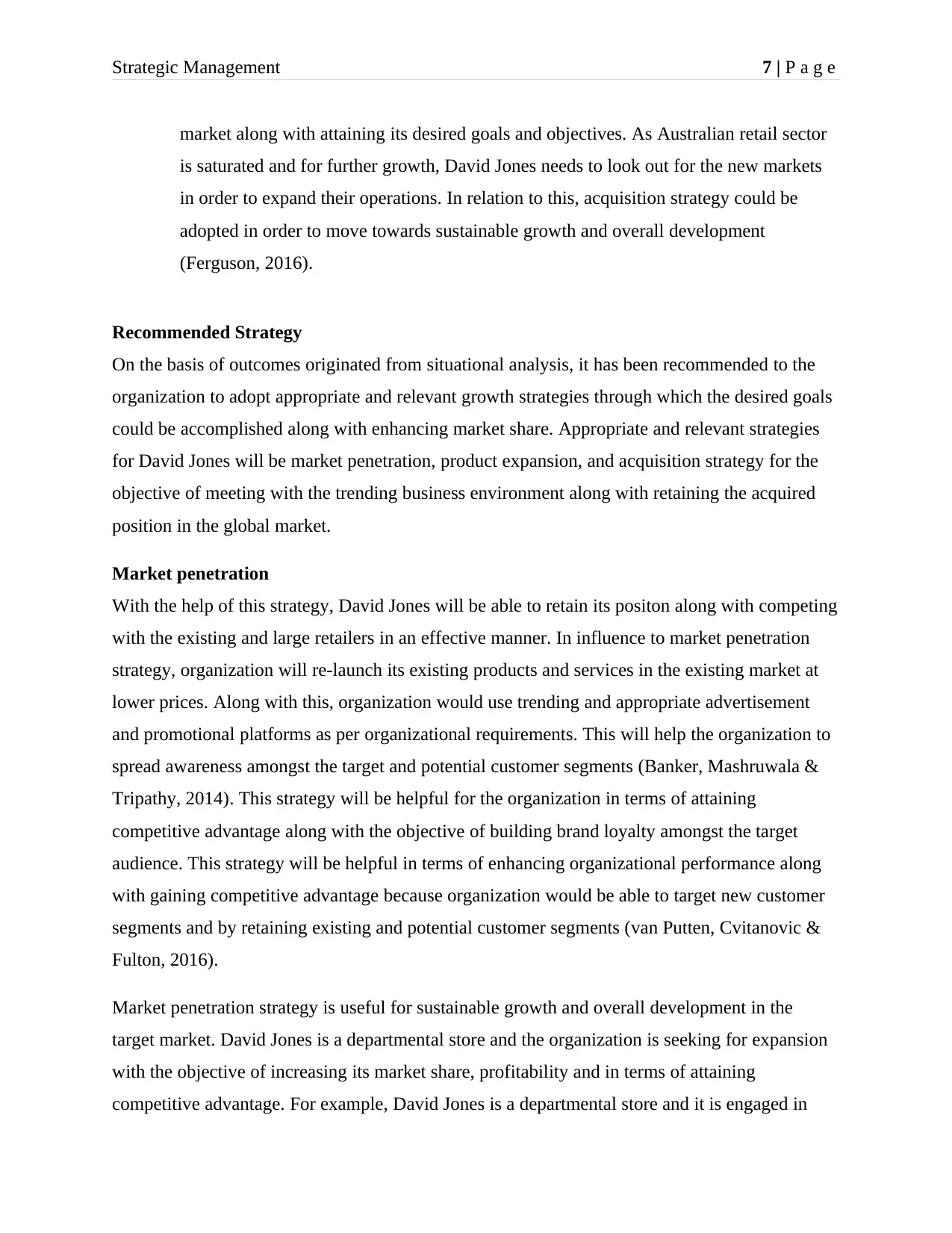
Strategic Management 7 | P a g e
market along with attaining its desired goals and objectives. As Australian retail sector
is saturated and for further growth, David Jones needs to look out for the new markets
in order to expand their operations. In relation to this, acquisition strategy could be
adopted in order to move towards sustainable growth and overall development
(Ferguson, 2016).
Recommended Strategy
On the basis of outcomes originated from situational analysis, it has been recommended to the
organization to adopt appropriate and relevant growth strategies through which the desired goals
could be accomplished along with enhancing market share. Appropriate and relevant strategies
for David Jones will be market penetration, product expansion, and acquisition strategy for the
objective of meeting with the trending business environment along with retaining the acquired
position in the global market.
Market penetration
With the help of this strategy, David Jones will be able to retain its positon along with competing
with the existing and large retailers in an effective manner. In influence to market penetration
strategy, organization will re-launch its existing products and services in the existing market at
lower prices. Along with this, organization would use trending and appropriate advertisement
and promotional platforms as per organizational requirements. This will help the organization to
spread awareness amongst the target and potential customer segments (Banker, Mashruwala &
Tripathy, 2014). This strategy will be helpful for the organization in terms of attaining
competitive advantage along with the objective of building brand loyalty amongst the target
audience. This strategy will be helpful in terms of enhancing organizational performance along
with gaining competitive advantage because organization would be able to target new customer
segments and by retaining existing and potential customer segments (van Putten, Cvitanovic &
Fulton, 2016).
Market penetration strategy is useful for sustainable growth and overall development in the
target market. David Jones is a departmental store and the organization is seeking for expansion
with the objective of increasing its market share, profitability and in terms of attaining
competitive advantage. For example, David Jones is a departmental store and it is engaged in
market along with attaining its desired goals and objectives. As Australian retail sector
is saturated and for further growth, David Jones needs to look out for the new markets
in order to expand their operations. In relation to this, acquisition strategy could be
adopted in order to move towards sustainable growth and overall development
(Ferguson, 2016).
Recommended Strategy
On the basis of outcomes originated from situational analysis, it has been recommended to the
organization to adopt appropriate and relevant growth strategies through which the desired goals
could be accomplished along with enhancing market share. Appropriate and relevant strategies
for David Jones will be market penetration, product expansion, and acquisition strategy for the
objective of meeting with the trending business environment along with retaining the acquired
position in the global market.
Market penetration
With the help of this strategy, David Jones will be able to retain its positon along with competing
with the existing and large retailers in an effective manner. In influence to market penetration
strategy, organization will re-launch its existing products and services in the existing market at
lower prices. Along with this, organization would use trending and appropriate advertisement
and promotional platforms as per organizational requirements. This will help the organization to
spread awareness amongst the target and potential customer segments (Banker, Mashruwala &
Tripathy, 2014). This strategy will be helpful for the organization in terms of attaining
competitive advantage along with the objective of building brand loyalty amongst the target
audience. This strategy will be helpful in terms of enhancing organizational performance along
with gaining competitive advantage because organization would be able to target new customer
segments and by retaining existing and potential customer segments (van Putten, Cvitanovic &
Fulton, 2016).
Market penetration strategy is useful for sustainable growth and overall development in the
target market. David Jones is a departmental store and the organization is seeking for expansion
with the objective of increasing its market share, profitability and in terms of attaining
competitive advantage. For example, David Jones is a departmental store and it is engaged in
Paraphrase This Document
Need a fresh take? Get an instant paraphrase of this document with our AI Paraphraser
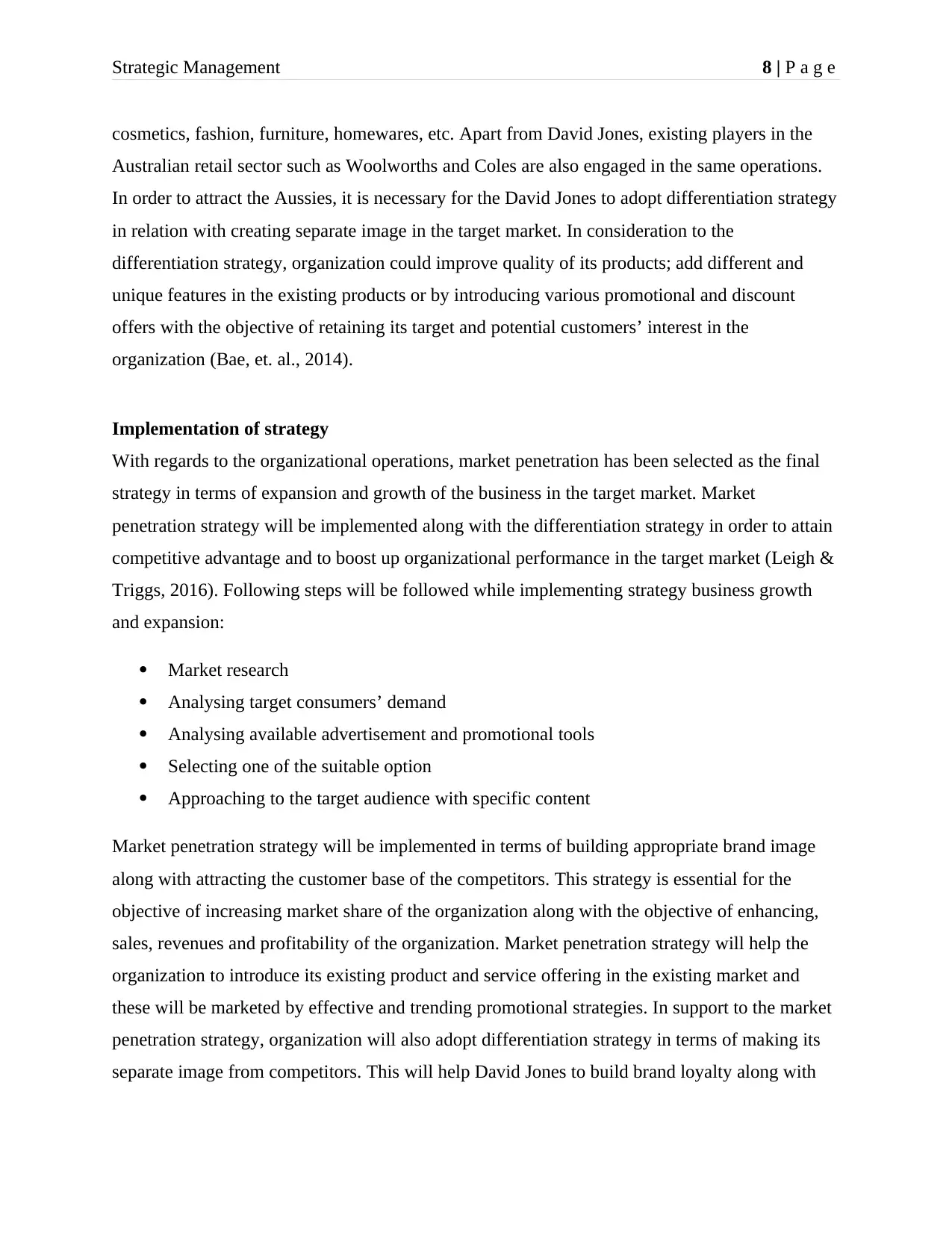
Strategic Management 8 | P a g e
cosmetics, fashion, furniture, homewares, etc. Apart from David Jones, existing players in the
Australian retail sector such as Woolworths and Coles are also engaged in the same operations.
In order to attract the Aussies, it is necessary for the David Jones to adopt differentiation strategy
in relation with creating separate image in the target market. In consideration to the
differentiation strategy, organization could improve quality of its products; add different and
unique features in the existing products or by introducing various promotional and discount
offers with the objective of retaining its target and potential customers’ interest in the
organization (Bae, et. al., 2014).
Implementation of strategy
With regards to the organizational operations, market penetration has been selected as the final
strategy in terms of expansion and growth of the business in the target market. Market
penetration strategy will be implemented along with the differentiation strategy in order to attain
competitive advantage and to boost up organizational performance in the target market (Leigh &
Triggs, 2016). Following steps will be followed while implementing strategy business growth
and expansion:
Market research
Analysing target consumers’ demand
Analysing available advertisement and promotional tools
Selecting one of the suitable option
Approaching to the target audience with specific content
Market penetration strategy will be implemented in terms of building appropriate brand image
along with attracting the customer base of the competitors. This strategy is essential for the
objective of increasing market share of the organization along with the objective of enhancing,
sales, revenues and profitability of the organization. Market penetration strategy will help the
organization to introduce its existing product and service offering in the existing market and
these will be marketed by effective and trending promotional strategies. In support to the market
penetration strategy, organization will also adopt differentiation strategy in terms of making its
separate image from competitors. This will help David Jones to build brand loyalty along with
cosmetics, fashion, furniture, homewares, etc. Apart from David Jones, existing players in the
Australian retail sector such as Woolworths and Coles are also engaged in the same operations.
In order to attract the Aussies, it is necessary for the David Jones to adopt differentiation strategy
in relation with creating separate image in the target market. In consideration to the
differentiation strategy, organization could improve quality of its products; add different and
unique features in the existing products or by introducing various promotional and discount
offers with the objective of retaining its target and potential customers’ interest in the
organization (Bae, et. al., 2014).
Implementation of strategy
With regards to the organizational operations, market penetration has been selected as the final
strategy in terms of expansion and growth of the business in the target market. Market
penetration strategy will be implemented along with the differentiation strategy in order to attain
competitive advantage and to boost up organizational performance in the target market (Leigh &
Triggs, 2016). Following steps will be followed while implementing strategy business growth
and expansion:
Market research
Analysing target consumers’ demand
Analysing available advertisement and promotional tools
Selecting one of the suitable option
Approaching to the target audience with specific content
Market penetration strategy will be implemented in terms of building appropriate brand image
along with attracting the customer base of the competitors. This strategy is essential for the
objective of increasing market share of the organization along with the objective of enhancing,
sales, revenues and profitability of the organization. Market penetration strategy will help the
organization to introduce its existing product and service offering in the existing market and
these will be marketed by effective and trending promotional strategies. In support to the market
penetration strategy, organization will also adopt differentiation strategy in terms of making its
separate image from competitors. This will help David Jones to build brand loyalty along with
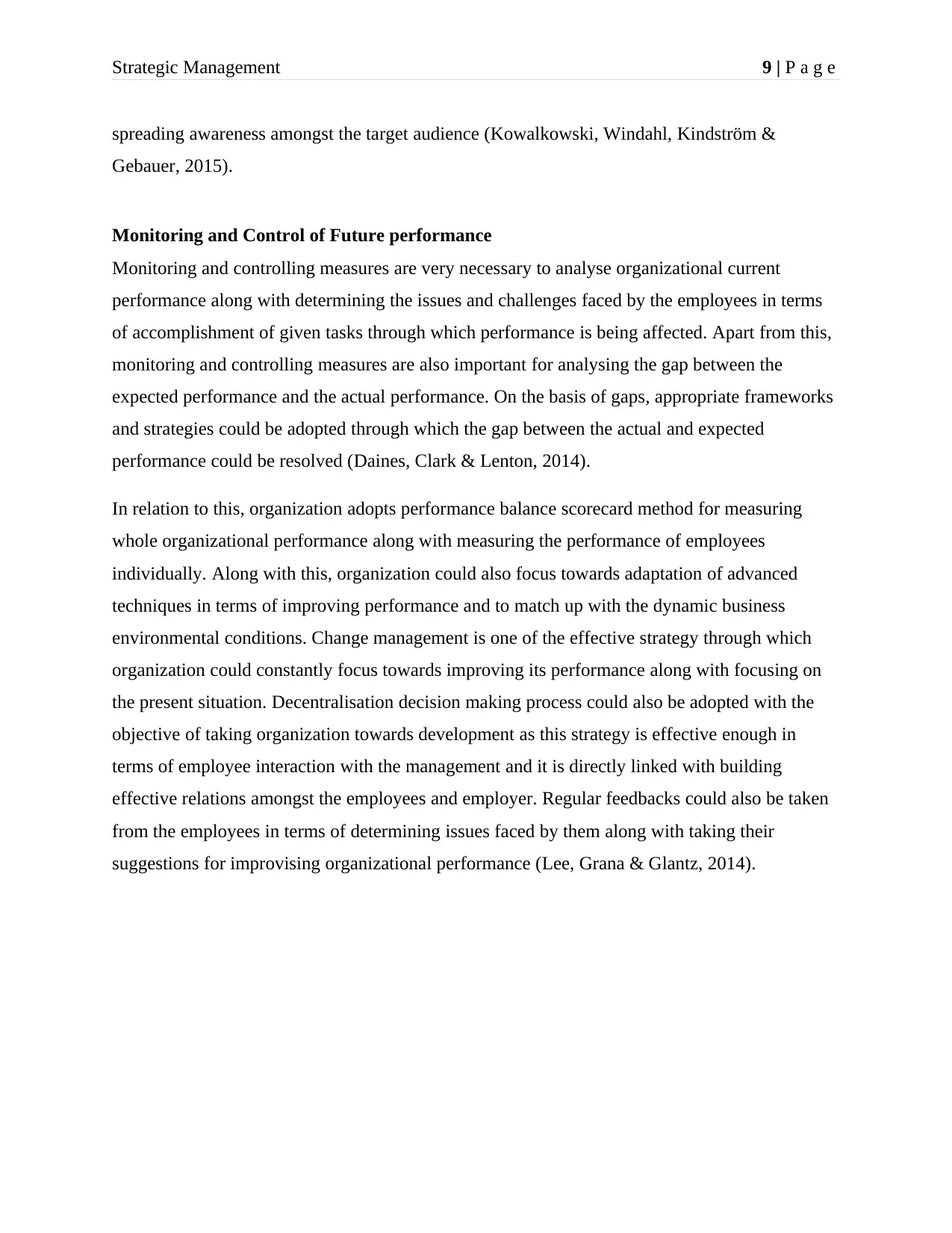
Strategic Management 9 | P a g e
spreading awareness amongst the target audience (Kowalkowski, Windahl, Kindström &
Gebauer, 2015).
Monitoring and Control of Future performance
Monitoring and controlling measures are very necessary to analyse organizational current
performance along with determining the issues and challenges faced by the employees in terms
of accomplishment of given tasks through which performance is being affected. Apart from this,
monitoring and controlling measures are also important for analysing the gap between the
expected performance and the actual performance. On the basis of gaps, appropriate frameworks
and strategies could be adopted through which the gap between the actual and expected
performance could be resolved (Daines, Clark & Lenton, 2014).
In relation to this, organization adopts performance balance scorecard method for measuring
whole organizational performance along with measuring the performance of employees
individually. Along with this, organization could also focus towards adaptation of advanced
techniques in terms of improving performance and to match up with the dynamic business
environmental conditions. Change management is one of the effective strategy through which
organization could constantly focus towards improving its performance along with focusing on
the present situation. Decentralisation decision making process could also be adopted with the
objective of taking organization towards development as this strategy is effective enough in
terms of employee interaction with the management and it is directly linked with building
effective relations amongst the employees and employer. Regular feedbacks could also be taken
from the employees in terms of determining issues faced by them along with taking their
suggestions for improvising organizational performance (Lee, Grana & Glantz, 2014).
spreading awareness amongst the target audience (Kowalkowski, Windahl, Kindström &
Gebauer, 2015).
Monitoring and Control of Future performance
Monitoring and controlling measures are very necessary to analyse organizational current
performance along with determining the issues and challenges faced by the employees in terms
of accomplishment of given tasks through which performance is being affected. Apart from this,
monitoring and controlling measures are also important for analysing the gap between the
expected performance and the actual performance. On the basis of gaps, appropriate frameworks
and strategies could be adopted through which the gap between the actual and expected
performance could be resolved (Daines, Clark & Lenton, 2014).
In relation to this, organization adopts performance balance scorecard method for measuring
whole organizational performance along with measuring the performance of employees
individually. Along with this, organization could also focus towards adaptation of advanced
techniques in terms of improving performance and to match up with the dynamic business
environmental conditions. Change management is one of the effective strategy through which
organization could constantly focus towards improving its performance along with focusing on
the present situation. Decentralisation decision making process could also be adopted with the
objective of taking organization towards development as this strategy is effective enough in
terms of employee interaction with the management and it is directly linked with building
effective relations amongst the employees and employer. Regular feedbacks could also be taken
from the employees in terms of determining issues faced by them along with taking their
suggestions for improvising organizational performance (Lee, Grana & Glantz, 2014).
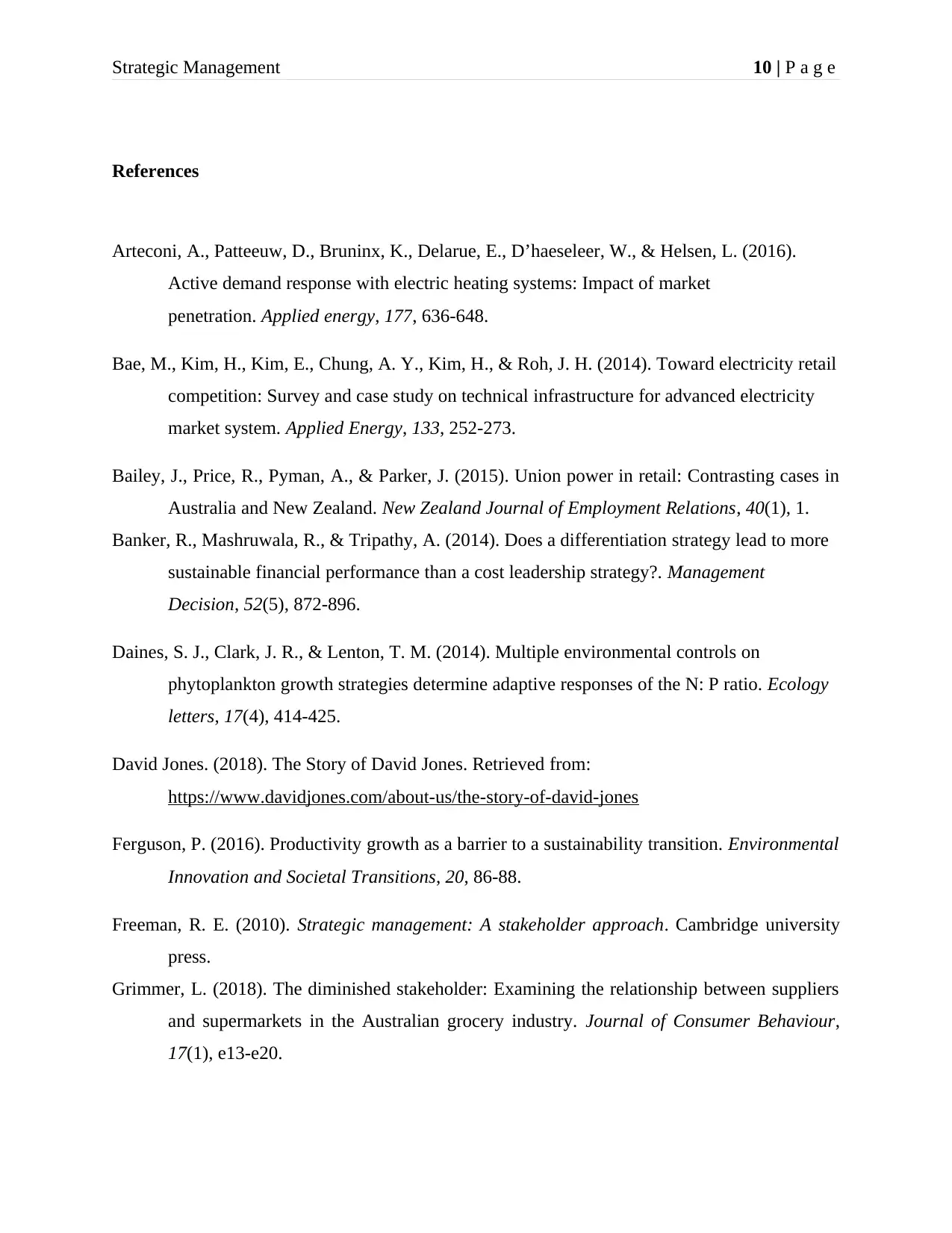
Strategic Management 10 | P a g e
References
Arteconi, A., Patteeuw, D., Bruninx, K., Delarue, E., D’haeseleer, W., & Helsen, L. (2016).
Active demand response with electric heating systems: Impact of market
penetration. Applied energy, 177, 636-648.
Bae, M., Kim, H., Kim, E., Chung, A. Y., Kim, H., & Roh, J. H. (2014). Toward electricity retail
competition: Survey and case study on technical infrastructure for advanced electricity
market system. Applied Energy, 133, 252-273.
Bailey, J., Price, R., Pyman, A., & Parker, J. (2015). Union power in retail: Contrasting cases in
Australia and New Zealand. New Zealand Journal of Employment Relations, 40(1), 1.
Banker, R., Mashruwala, R., & Tripathy, A. (2014). Does a differentiation strategy lead to more
sustainable financial performance than a cost leadership strategy?. Management
Decision, 52(5), 872-896.
Daines, S. J., Clark, J. R., & Lenton, T. M. (2014). Multiple environmental controls on
phytoplankton growth strategies determine adaptive responses of the N: P ratio. Ecology
letters, 17(4), 414-425.
David Jones. (2018). The Story of David Jones. Retrieved from:
https://www.davidjones.com/about-us/the-story-of-david-jones
Ferguson, P. (2016). Productivity growth as a barrier to a sustainability transition. Environmental
Innovation and Societal Transitions, 20, 86-88.
Freeman, R. E. (2010). Strategic management: A stakeholder approach. Cambridge university
press.
Grimmer, L. (2018). The diminished stakeholder: Examining the relationship between suppliers
and supermarkets in the Australian grocery industry. Journal of Consumer Behaviour,
17(1), e13-e20.
References
Arteconi, A., Patteeuw, D., Bruninx, K., Delarue, E., D’haeseleer, W., & Helsen, L. (2016).
Active demand response with electric heating systems: Impact of market
penetration. Applied energy, 177, 636-648.
Bae, M., Kim, H., Kim, E., Chung, A. Y., Kim, H., & Roh, J. H. (2014). Toward electricity retail
competition: Survey and case study on technical infrastructure for advanced electricity
market system. Applied Energy, 133, 252-273.
Bailey, J., Price, R., Pyman, A., & Parker, J. (2015). Union power in retail: Contrasting cases in
Australia and New Zealand. New Zealand Journal of Employment Relations, 40(1), 1.
Banker, R., Mashruwala, R., & Tripathy, A. (2014). Does a differentiation strategy lead to more
sustainable financial performance than a cost leadership strategy?. Management
Decision, 52(5), 872-896.
Daines, S. J., Clark, J. R., & Lenton, T. M. (2014). Multiple environmental controls on
phytoplankton growth strategies determine adaptive responses of the N: P ratio. Ecology
letters, 17(4), 414-425.
David Jones. (2018). The Story of David Jones. Retrieved from:
https://www.davidjones.com/about-us/the-story-of-david-jones
Ferguson, P. (2016). Productivity growth as a barrier to a sustainability transition. Environmental
Innovation and Societal Transitions, 20, 86-88.
Freeman, R. E. (2010). Strategic management: A stakeholder approach. Cambridge university
press.
Grimmer, L. (2018). The diminished stakeholder: Examining the relationship between suppliers
and supermarkets in the Australian grocery industry. Journal of Consumer Behaviour,
17(1), e13-e20.
Secure Best Marks with AI Grader
Need help grading? Try our AI Grader for instant feedback on your assignments.
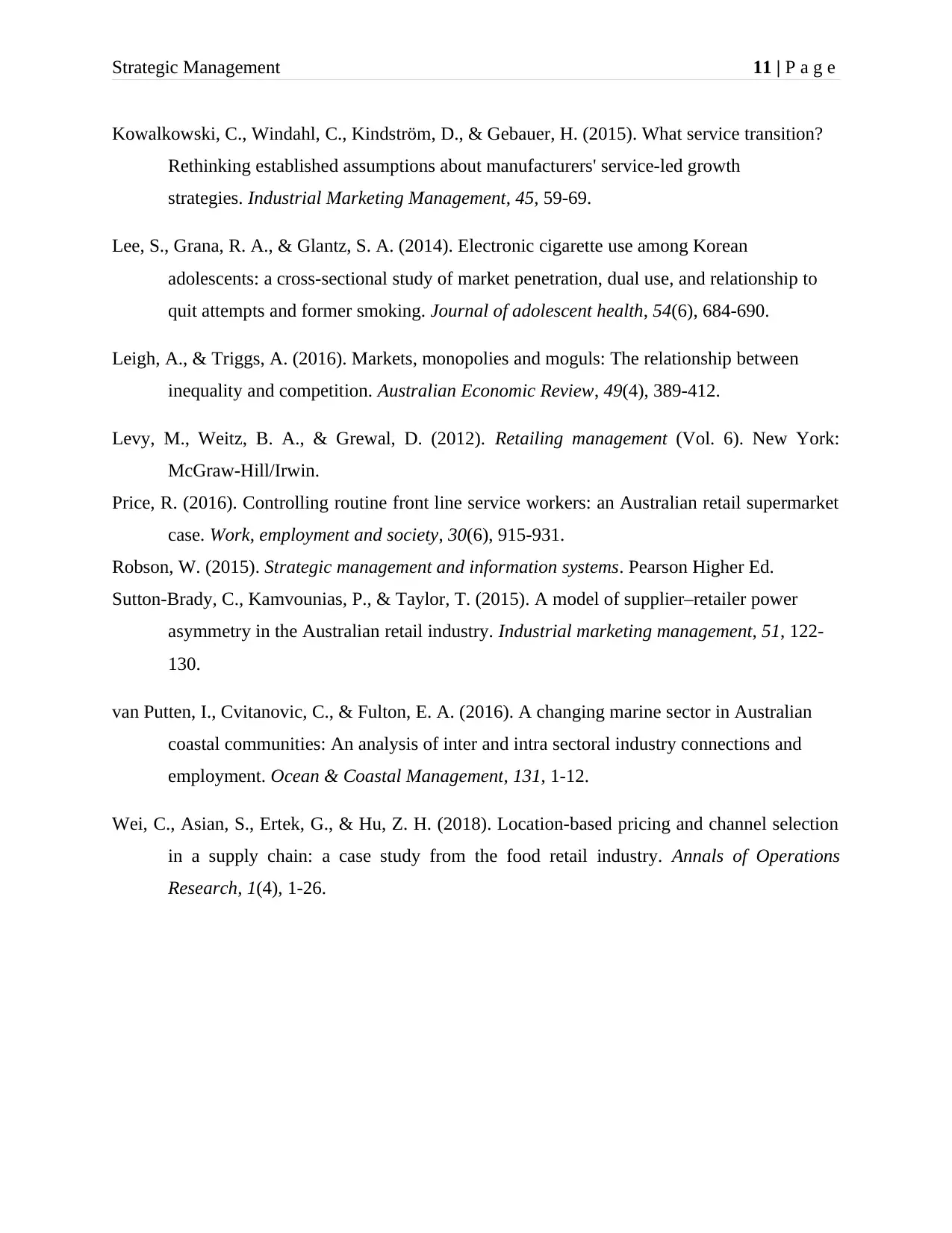
Strategic Management 11 | P a g e
Kowalkowski, C., Windahl, C., Kindström, D., & Gebauer, H. (2015). What service transition?
Rethinking established assumptions about manufacturers' service-led growth
strategies. Industrial Marketing Management, 45, 59-69.
Lee, S., Grana, R. A., & Glantz, S. A. (2014). Electronic cigarette use among Korean
adolescents: a cross-sectional study of market penetration, dual use, and relationship to
quit attempts and former smoking. Journal of adolescent health, 54(6), 684-690.
Leigh, A., & Triggs, A. (2016). Markets, monopolies and moguls: The relationship between
inequality and competition. Australian Economic Review, 49(4), 389-412.
Levy, M., Weitz, B. A., & Grewal, D. (2012). Retailing management (Vol. 6). New York:
McGraw-Hill/Irwin.
Price, R. (2016). Controlling routine front line service workers: an Australian retail supermarket
case. Work, employment and society, 30(6), 915-931.
Robson, W. (2015). Strategic management and information systems. Pearson Higher Ed.
Sutton-Brady, C., Kamvounias, P., & Taylor, T. (2015). A model of supplier–retailer power
asymmetry in the Australian retail industry. Industrial marketing management, 51, 122-
130.
van Putten, I., Cvitanovic, C., & Fulton, E. A. (2016). A changing marine sector in Australian
coastal communities: An analysis of inter and intra sectoral industry connections and
employment. Ocean & Coastal Management, 131, 1-12.
Wei, C., Asian, S., Ertek, G., & Hu, Z. H. (2018). Location-based pricing and channel selection
in a supply chain: a case study from the food retail industry. Annals of Operations
Research, 1(4), 1-26.
Kowalkowski, C., Windahl, C., Kindström, D., & Gebauer, H. (2015). What service transition?
Rethinking established assumptions about manufacturers' service-led growth
strategies. Industrial Marketing Management, 45, 59-69.
Lee, S., Grana, R. A., & Glantz, S. A. (2014). Electronic cigarette use among Korean
adolescents: a cross-sectional study of market penetration, dual use, and relationship to
quit attempts and former smoking. Journal of adolescent health, 54(6), 684-690.
Leigh, A., & Triggs, A. (2016). Markets, monopolies and moguls: The relationship between
inequality and competition. Australian Economic Review, 49(4), 389-412.
Levy, M., Weitz, B. A., & Grewal, D. (2012). Retailing management (Vol. 6). New York:
McGraw-Hill/Irwin.
Price, R. (2016). Controlling routine front line service workers: an Australian retail supermarket
case. Work, employment and society, 30(6), 915-931.
Robson, W. (2015). Strategic management and information systems. Pearson Higher Ed.
Sutton-Brady, C., Kamvounias, P., & Taylor, T. (2015). A model of supplier–retailer power
asymmetry in the Australian retail industry. Industrial marketing management, 51, 122-
130.
van Putten, I., Cvitanovic, C., & Fulton, E. A. (2016). A changing marine sector in Australian
coastal communities: An analysis of inter and intra sectoral industry connections and
employment. Ocean & Coastal Management, 131, 1-12.
Wei, C., Asian, S., Ertek, G., & Hu, Z. H. (2018). Location-based pricing and channel selection
in a supply chain: a case study from the food retail industry. Annals of Operations
Research, 1(4), 1-26.
1 out of 11
Related Documents
Your All-in-One AI-Powered Toolkit for Academic Success.
+13062052269
info@desklib.com
Available 24*7 on WhatsApp / Email
![[object Object]](/_next/static/media/star-bottom.7253800d.svg)
Unlock your academic potential
© 2024 | Zucol Services PVT LTD | All rights reserved.



